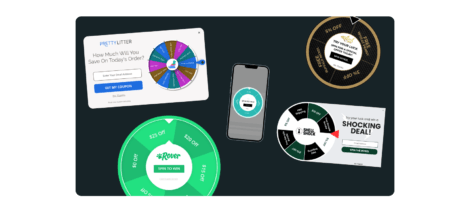Any business seeking to thrive in a competitive market must have an effective online presence. And while attracting visitors to your website is important, the ultimate goal is to convert those visitors into paying customers or engaged users. This is where mastering website conversion becomes essential. Whether it’s making a purchase, signing up for a newsletter, or filling out a form, a high converting website is built to engage and persuade users to complete those activities. In this blog post, we’ll delve into the factors that make up a website that converts, arming you with the knowledge you need to strengthen your digital footprint and see impressive outcomes.

Photo by Kevin Bhagat on Unsplash
What Is Website Conversion?
Website conversion refers to the process of turning website visitors into desired actions or outcomes. It involves persuading and encouraging visitors to take specific actions that align with the goals of a business or website owner. Depending on the goals of the website, these metrics may include purchases, newsletter signups, contact form submissions, resource downloads, or something else entirely.
On average, websites across industries have a conversion rate of 2.35%. However, it’s important to note that conversion rates vary among different sectors, with some industries achieving higher rates while others experience lower rates. This highlights the potential for significant improvements in conversion rates and serves as a benchmark for businesses aiming to optimize their website’s performance.
Understanding Conversion Optimization
Conversion optimization is the process of enhancing a website’s effectiveness in converting visitors into desired actions, such as making a purchase, filling out a form, or subscribing to a service. It involves analyzing user behavior, identifying areas of improvement, and implementing strategic changes to increase the likelihood of conversions. Below are the most important elements that contribute to a website that converts:
Clear Copy
Clear copy plays a vital role in website conversion as it directly impacts how effectively your message is communicated to your audience. When visitors land on your site, they seek information that is concise, easily understandable, and relevant to their needs.
Clear copy helps convey your value proposition, key messages, and the benefits of your products or services in a compelling manner. Visitors can quickly grasp the essence of what your business offers and learn why they should choose you over competitors. It eliminates confusion, reduces bounce rates, and increases the likelihood of visitors taking desired actions, ultimately leading to higher conversion rates.
Invest time and effort in crafting clear, persuasive copy that speaks directly to your target audience and guides them seamlessly through the conversion journey. Break down complex information into digestible chunks and avoid jargon or confusing language to create a user-friendly experience that builds trust and engagement.
Visual Appeal
The impact of eye-catching photos on your website cannot be understated in today’s visually-focused environment. Humans are naturally drawn to aesthetics, so adding excellent images, videos, and graphics may have a big impact on how successful your website is.
By carefully creating your images, you can boost user engagement while also raising conversion rates, which can eventually help your online marketing campaigns succeed. Make sure to employ visuals that both fit with and appeal to your brand’s intended audience.
Responsive Design and Intuitive Navigation
Responsive design and intuitive navigation are crucial components of conversion rate optimization strategies. With the increasing use of mobile devices, having a website that seamlessly adapts to different screen sizes is essential for providing a positive user experience. A responsive design ensures that visitors can easily access and navigate your site on any device, reducing friction and increasing the likelihood of conversion.
Additionally, intuitive navigation and design organizes your content in a logical and user-friendly manner, allowing visitors to find the information they need quickly and effortlessly. Prioritizing responsive design and intuitive navigation helps you create a seamless and user-friendly experience that builds trust, encourages engagement, and ultimately leads to higher conversion rates.
Fast Loading Speed
In today’s fast-paced environment, website visitors have high expectations for instantaneous page loading. If your website takes too slow to load, you risk losing customers who will become frustrated and look elsewhere.
To speed up your website, you can use cache, image compression, and code reduction. Additionally, investing in solid hosting, enhancing the website’s visibility in search engines, and improving the user experience also increase the likelihood that visitors will make a purchase.
Call-to-Actions (CTAs)
Call-to-Actions (CTAs) are crucial elements of a website that prompt users to take a specific action. They serve as guiding signposts that direct users toward the desired conversion goals.
Use action-oriented language that creates a sense of urgency or excitement, such as “Buy Now,” “Sign Up Today,” or “Get Started.” Position CTAs where users are most likely to see them, such as above the fold, at the end of a page, or in the center of the screen. Moreover, employ visual cues, such as contrasting colors, whitespace, or arrows, to draw attention to the CTA. The design should make it stand out from the rest of the page. Use contrasting colors that complement your website’s color scheme to create visual impact.
Additionally, ensure that CTAs are large enough to be easily clickable and tap-friendly on mobile devices. The size should be proportionate to the surrounding elements, making it noticeable without overpowering the overall design. Finally, make sure to strike a balance between visibility and maintaining a cohesive visual hierarchy on the page.
Streamlining the Conversion Funnel
Streamlining the conversion funnel is a critical aspect of conversion optimization. Understanding what it is exactly and implementing strategies to simplify the user journey increase the likelihood of converting visitors into customers.
Understanding the Conversion Funnel and Its Stages
The conversion funnel is a conceptual framework that illustrates the journey a potential customer goes through from the initial awareness stage to the final conversion or purchase stage. It represents the stages of the customer’s decision-making process and the gradual narrowing down of prospects as they move closer to becoming customers. The typical stages of the conversion funnel include:
- Awareness. Potential clients’ first encounter with your company and its offerings. They may discover you through various channels such as search engines, social media, or referrals.
- Interest. In this stage, visitors show interest in your offerings and explore further. They engage with your website, browse products or services, and seek more information.
- Desire. Visitors develop a strong desire for your offerings. They may compare options, read reviews, or evaluate pricing to determine if your product or service meets their needs.
- Action. The final stage is where visitors take the desired action, such as making a purchase, signing up for a service, or submitting a form. This is the ultimate goal of the conversion funnel.
Strategies for Simplifying the User Journey
- Clear and Intuitive Navigation. Check that your website’s menus are simple and easy to use. Visitors should be able to easily find the information they need and navigate from one stage of the funnel to the next without confusion.
- Streamlined Forms. If forms are involved in the conversion process, keep them concise and user-friendly. Only ask for essential information and eliminate any unnecessary fields. Using progress indicators and providing clear instructions can help simplify the form completion process.
- Personalization. Tailor the user experience based on visitor behavior and preferences. Leverage data and segmentation to deliver relevant content, product recommendations, or offers, guiding visitors through the funnel based on their specific needs and interests.
- Simplified Checkout Process. If the conversion involves a purchase, streamline the checkout process to minimize friction. Offer guest checkout options, provide clear and transparent pricing, and simplify the steps required to complete the purchase.
Tips on Building Trust and Addressing Objections Throughout the Funnel
- Social Proof. Incorporate social proof elements such as customer testimonials, reviews, case studies, or ratings to build trust and credibility. Highlight positive experiences and showcase how your offerings have benefited others.
- Clear Value Proposition. Clearly communicate the unique value and benefits of your product or service throughout the funnel. Show visitors how your offerings solve their problems, meet their needs, or improve their lives.
- Addressing Objections. Anticipate and address common objections or concerns that visitors may have. Provide clear and detailed information about pricing, guarantees, return policies, or any potential barriers to conversion. Addressing objections proactively can alleviate doubts and increase confidence in the decision-making process.
Website Conversion and SEO
Optimizing your website for search engines is a critical aspect of improving website visibility and driving organic traffic. When implemented effectively, SEO can have a significant impact on conversion rates. Here’s a closer look at the importance of optimizing for search engines and the key strategies involved:
The Impact of SEO on Conversion Rates
By optimizing your website for search engines, you improve its chances of appearing in top search results. This increased visibility exposes your website to a larger audience, increasing the potential for conversions.
SEO also helps attract relevant and targeted traffic to your website. When your site appears in search results for keywords related to your business, you’re more likely to attract users who are actively searching for products or services you offer, increasing the likelihood of conversion.
Moreover, websites that rank higher in search results are often perceived as more trustworthy and credible by users. By appearing on the first page of search results, you establish credibility and instill confidence in potential customers, leading to higher conversion rates.
SEO Strategies that Lead to High Conversion Rates
- Keyword Research. You will learn what words and phrases your target market uses to find products and services by conducting extensive keyword research. Then, you can incorporate these keywords strategically into your website’s content, meta tags, headings, and URLs to increase the relevance of your site to search engines, thus improving its visibility and attracting qualified traffic.
- On-Page Optimization. Optimizing on-page elements such as title tags, meta descriptions, and header tags helps search engines understand the content and purpose of each page. Clear and optimized on-page elements enhance search engine rankings and also provide users with relevant information in search results, increasing the likelihood of click-throughs and conversions.
- Quality Backlinks. Backlinks from reputable and relevant websites act as endorsements for your website’s authority and quality. Acquiring high-quality backlinks through content marketing, guest blogging, or partnerships signals to search engines that your website can be trusted and has some sort of value to the readers. This, in turn, improves your search engine rankings and drives more organic traffic, resulting in higher conversion rates.
- Optimizing Site Speed. User experience is a crucial factor in conversion optimization, and site speed plays a significant role. Optimizing your website’s loading speed improves user satisfaction and reduces bounce rates. Users are more likely to stay on a website that loads quickly, increasing the chances of exploring further and converting. Additionally, search engines prioritize fast-loading websites, leading to better visibility and potential conversions.
Analyzing and Tracking Conversion Metrics
Analyzing and tracking conversion metrics is a crucial step in understanding the effectiveness of your marketing and optimization efforts. When you are measuring and interpreting key conversion metrics, you can gain valuable insights into your website’s performance and make data-driven decisions to improve conversion rates. Let’s take a look at the advantages of analyzing and tracking conversion metrics:
Understanding User Behavior
Conversion metrics such as click-through rates, bounce rates, time on page, and conversion rates, provide valuable information about how users interact with your website. For example, a high bounce rate may indicate that your landing page needs optimization, while a low conversion rate may suggest issues with your CTA or checkout process. Analyzing these metrics helps you understand how users engage with your website and identify opportunities to optimize the user experience.
Identifying Conversion Funnel Bottlenecks
Conversion metrics enable you to identify specific stages in your conversion funnel where visitors may be dropping off or encountering obstacles. Metrics such as funnel conversion rates, exit rates, and abandonment rates help you pinpoint bottlenecks in your conversion process. This allows you to take targeted actions to optimize those specific stages and improve the overall conversion rate. If you see that a lot of people are bailing out at the payment page, for instance, you may work to eliminate any barriers to conversion by making the payment process easier.
Measuring Marketing Campaign Effectiveness
Conversion metrics help you evaluate the performance of your marketing campaigns. When tracking metrics such as conversion rate by traffic source, you can determine which marketing channels and campaigns are driving the most conversions. This insight allows you to allocate your marketing resources effectively, optimize campaigns that are performing well, and identify areas where adjustments may be needed.
A/B Testing and Optimization
Conversion metrics are essential for conducting A/B tests and optimization experiments. Comparing different variations of your landing pages, CTAs, or other conversion elements and tracking relevant metrics helps you determine which variations are more effective in driving conversions. This iterative process of testing, analyzing metrics, and implementing improvements helps you refine your website and marketing strategies over time, ultimately increasing conversion rates.
Setting and Monitoring Goals
Conversion metrics enable you to set specific goals and monitor progress toward those goals. Whether it’s increasing the number of purchases, generating leads, or driving newsletter sign-ups, tracking conversion metrics allows you to measure the success of your efforts and make informed decisions based on real-time data. Regularly monitoring conversion metrics helps you stay focused, track performance trends, and adjust your strategies to achieve your desired outcomes.

Photo by KOBU Agency on Unsplash
Key Elements of a Website that Converts: The Bottom Line
In today’s highly competitive online landscape, mastering the optimization of your website’s conversion rate is essential for achieving success. Keep in mind that the road to a website that converts is a never-ending one, requiring constant attention to the needs, wants, and habits of your target audience.
Ready to witness the transformative power of our expert conversion specialists on your website’s user experience and conversion rate? Book a complimentary 100% free conversion audit today and iscover how an optimized customer experience from Justuno can revolutionize your business and propel your conversions to new heights.




